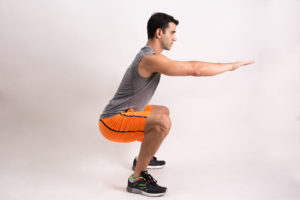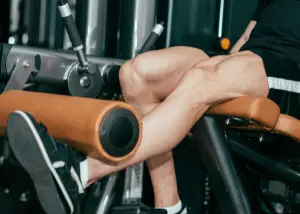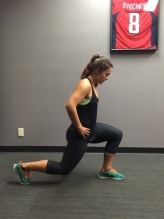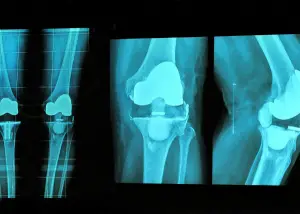If you’ve had a total knee replacement, weight lifting and resistance training may be something that you want to consider. Lifting weights can help build muscle, improve bone density, and help maintain balance and coordination.
After a total knee replacement, you must build up the muscles and gain strength in the leg. However, it can take up to a full year to recover from a knee replacement, and you won’t be in physical therapy during that entire year. You are going to have to continue with strengthening exercises long after and be compliant.
Research shows that leg strength helps total knee replacement prosthesis last longer, there is less pain, and you’re able to return to sports such as skiing and tennis much faster.
In this blog post, we’ll cover all you need to know about resistance training and weight lifting and give you guidance on how to approach it correctly.
Weight Lifting After A Total Knee Replacement
 Lifting weights and improving your overall strength is paramount to fully recovering after a total knee replacement. Most often, rehab programs stop after a total knee replacement will go for 6-8 weeks after surgery and put the majority of the pressure on the patient to regain the remainder of their strength. Strength takes a long time to build back after surgery.
Lifting weights and improving your overall strength is paramount to fully recovering after a total knee replacement. Most often, rehab programs stop after a total knee replacement will go for 6-8 weeks after surgery and put the majority of the pressure on the patient to regain the remainder of their strength. Strength takes a long time to build back after surgery.
Leg and quad strength has been shown to decrease pain levels in the knee after surgery, reduce the rate of revisions of total knee replacement, and reduce the risk of causing other joint pain such as hip and low back pain due to compensations for weakness.
We see it always where a patient will come in with a new onset of back pain 2-3 months after a knee replacement because of the compensations. Then you forget about the knee strengthening and focus on the new aches and pains and before you know it have a long-term weakness.
In short, is resistance exercise and weight lifting beneficial after a knee replacement?
Absolutely! Not only is it completely safe, but it’s the best way to heal and recover from a knee replacement fully.
When Can You Return to Lifting Weights After a Knee Replacement
You will begin strengthening exercises after a total knee replacement around 4-6 weeks after surgery. However, these are relatively light and easy to protect the new joint as it heals. From that point forward, you will slowly begin to increase the weight and resistance of the exercises.
After 6-8 weeks from surgery, you can begin your exercises in the gym and weight lifting.
However, it is essential to be careful and slowly return to weightlifting after a total knee replacement.
Resistance training should always start low weight/low reps and work up gradually as you progress throughout the recovery period. It would be best if you did not have any joint pain during or after the exercise.
By 12 weeks from surgery, you can start working in heavier resistance exercises such as squats, lunges, and deadlifts. However, make sure that you are still as resistance levels much lighter than you normally would lift.
Lifting Exercises to Avoid After a Knee Replacement
If weight lifting after a total knee replacement is something you are interested in, then it’s important to know what weightlifting exercises should be avoided.
There is no such thing as bad exercise. The timing, intensity, and resistance levels may be inappropriate for that stage of healing.
Exercises that you be cautious with are:
- Deep, weighted squats
- Heavy leg press
- Heavy Lunges
- Plyometrics such as jumping, running and hopping
- Any exercises with prolonged kneeling on the surgical knee
What Gym Exercises are Safe After a Knee Replacement
Most exercises are safe after a total knee replacement as long as they are done with lighter weight and higher reps.
These include lightweight squats, step-ups, mini lunges, and lighter leg presses. Even weighted knee extensions are safe to do. Sometimes this exercise gets beat up unnecessarily, but it is perfectly safe to perform and an excellent way to build up quadriceps strength.
Squats after a Knee Replacement
Squats are great to do after a knee replacement. We recommend starting with bodyweight squats and ensuring that you can perform these with equal weight-bearing in both legs.
You can go down to 90-degrees of knee bend, but you don’t have to. Listen to your body and build up enough strength to improve the depth of the squat.

The next progression is to use dumbbells and hold them by your side. Start with 5-10 pound weights in each hand, and again make sure that you can put the weight evenly in both legs.
Finally, you can progress to barbell squats but start with the bar only. You can progress by 10-15% each week in terms of weight added and the repetitions. We typically don’t recommend starting barbell squats until at least 5-6 months after surgery or later.
You may have to play with the position of your hips, either forward or backward, to make it more comfortable for your knee.
Leg press After a Knee Replacement
The leg press is another great exercise to do after a knee replacement.
There are two types of leg press machines: one where the platform moves with your feet and one where the feet stay still and the chair moves. We prefer the sled moves and the feet remain in place, but both are fine to use after knee surgery.

You can start this early in your recovery if you use light weights, somewhere around 4 weeks after surgery. Use both feet at the same time and focus on putting equal weight on both feet.
From there, you can progress to a single-leg press to strengthen the surgical leg, but you’ll need to continue to use light weights.
Knee Extension Machine After a Knee Replacement
This exercise is a great way to strengthen the quad muscle without putting too much pressure on the newly replaced knee joint. This again needs to be low weights and high repetitions.
This exercise often gets a bad reputation after surgery for causing high pressure in the knee cap; however, after a knee replacement, this exercise is quite safe and one of our favorites to use.
Start out using both legs and stick with low weight and high repetition. As you get stronger, then you can progress to single-leg for this exercise.

Lunges After a Knee Replacement
This is an exercise that we like to wait before starting after a knee replacement. Lunges place more stress on the knee joint than other exercises. We want to wait until 5-6 weeks to start true lunges. We start small mini lunges in therapy between the 3-4 weeks after surgery, but these are assisted with a railing or counter and are small excursions. The risk of starting full lunges too early is an injury to the quad or the quad tendon.

At 5-6 weeks after surgery, start with bodyweight reverse lunges. Reverse lunges put less pressure on your knee joint and are much more comfortable early on after surgery. Start with small movements, and over the next 6 weeks, gradually progress your depth of movement.
At 8-12 weeks after surgery, you can begin to work in other types of lunges. This includes a lateral lunge and a forward lunge. We still recommend using only bodyweight until you can perform this exercise with minimal pain and no residual swelling AFTER you are done working out.
By 5-6 months after surgery, you can start to increase the resistance with your lunges. Start with holding light dumbbells by your side first and make sure you can perform with proper form and not compensate with the non-surgical leg. Once you can successfully lunge with 20-pounds dumbbells in each hand 30x, then you can progress to barbell lunges with only the bar. This may take up to 8-9 months after surgery.
Pro Tip: It takes a full year until you feel mostly normal after a knee replacement
What are the Benefits of Weight Lifting After a Knee Replacement?
There are many benefits to weightlifting after knee replacement. If done correctly, it can help decrease pain levels in your surgical joint while improving flexibility, balance, and cardiovascular health. In addition, there are a few other important benefits of lifting weights after the surgery.
Improves Muscle Health and Strength
Your muscles will atrophy and lose strength over the time it takes to recover from a knee replacement. The best way to prevent this is to perform resistance exercises. Muscle strength is a predictor of falls and overall mortality rates in people over 65, so it’s important to keep working on strength training. Strength is also vital for decreasing the pain you might feel in your knee joint and keeping the nerves and muscles in the leg healthy.
Improve Bone Density
When you weight lift after surgery, it helps to increase bone density. The more resistance exercises you can perform on your leg post-surgery, the better the chance of maintaining stronger bones and less risk for osteoporosis. The best exercise is squats but makes sure it’s appropriately performed with no pain or swelling during or after weight lifting. This is particularly important for female patients who have a greater risk of developing osteoporosis.
Helps Lose Weight After Surgery
If weight lifting is combined with a healthy diet, it can help you lose weight in the long term. Weight loss will help decrease your risk for heart disease and other obesity-related problems more prevalent in people over the age of 50. Weight loss even helps preserve the knee replacement and helps your knee replacement last 20-25 years after surgery. This weight loss can also lead to further decreases in pain levels associated with knee surgery.
Reduces Injury Risk
Strength is protective against injuries. This includes, most important, preventing falls in the elderly, which is important after a knee replacement. The mortality rate of a severe fall after the age of 70 is astonishingly high. Also, the few times that we have seen a knee replacement fail is after someone fell on a curb or in the bathroom and landed on their new knee.

Strength also prevents injuries to the surrounding joints. The stronger the knee and quad are, the less likely you will compensate with other joints such as the hip or the back. If you never develop proper strength after surgery, the chances of aggravating your back or hip are quite high.
Improves Heart Health
Lifting weight after knee surgery helps to improve heart health. This is due to the weight loss effects of weight lifting, the increased pumping demands of the heart, and if combined with cardio exercise, will help decrease your risk for all cardiovascular diseases. Exercise helps with heart muscle strength, atherosclerosis and helps with reducing blood pressure.
Decreases Risk of Having a Total Knee Replacement Revision
If proper technique and progression are performed with weight lifting from a knee replacement, you can decrease the risk of having a knee replacement revision. Total knee replacements last between 20-25 years as of the writing of this article. One of the best ways to preserve the longevity of the prosthesis is by having enough strength in the quad and hip.
The more strength you have in the leg, the less pressure on the prosthesis, and the slower it will wear out.
Helpful Tips For Lifting Weights After a Knee Replacement
Weight lifting can be intimidating after major surgery, such as a knee replacement, but here are a few helpful tips to ensure that you do it safely and correctly.
Go Slow With Increasing Weight and Reps
It’s critically important that you start with lighter weights as you return to the gym after a knee replacement. If you are unsure of a good starting weight, ask your physical therapist or start at no weight and work up gradually from there. You won’t be able to progress as fast as you could when you were younger or even before surgery.
Use Lighter Weight and Higher Reps
You’ll want to stay with low weight and high reps for the first year of recovery. This helps protect the joint while building up muscles at the same time. Try for 10-20 reps and 2-3 sets for each exercise. If you can’t perform 10 reps, then reduce your weight and go for more reps until you can do 20 reps and then increase the weight.

Rest an Extra Day Longer
After knee surgery, we recommend taking an extra day off between days of working out. You’ll want to give yourself a little more rest time between workouts to let everything recover, especially during the first 2 weeks that you return to the gym. Instead of taking 1 day off between working out, you might start at 2 days. Take an extra day off if needed and listen to your body and watch for changes in swelling. If your knee doesn’t swell up after working out, you can start to work out with fewer days of rest in between.
What to Avoid At the Gym After a Knee Replacement
There are no bad exercises, just exercises that are performed at the wrong time and with the wrong amount of weight. With that being said, there are a few things that we recommend avoiding when you return to the gym after knee replacement to prevent an injury.
Exercises to avoid include:
- Deep squats beyond 90 degrees, particularly within 6 months of surgery
- Heavy weighted squats with an uncomfortable weight
- Any exercise that has weight and you kneeling on the knee replacement
- Any hard jumping or plyometrics such as box jumps for the first year after surgery
Conclusion
Weight lifting after knee surgery is safe when performed at the right weight and with proper technique. You can help increase strength in your quad and hip, which decreases wear on the total knee replacement, improves heart health, and helps reduce overall pain levels. It’s important to go slow with increasing resistance during weight lifting sessions due to a healing knee and less muscle strength. Make sure lifting after a total knee replacement is performed with proper weight, reps, and rest time to ensure safe exercises.
GLP Weight Loss and Back Health: Effective Strategies and Insights
How to Stay Active After Cervical Fractures: Expert Tips and Advice
Dealing with Painful Stairs After Ankle Replacement Surgery
Walking After a Total Ankle Replacement: Tips for a Successful Recovery
Exercises While Non-Weight Bearing After Ankle Replacement: Elevation, AROM, Leg Raises, and More
Ankle Pain with Stairs: Causes and Home Treatment Options
Disclaimer: The information provided in this post is for educational purposes only. This is not a substitute for a medical appointment. Please refer to your physician before starting any exercise program.






